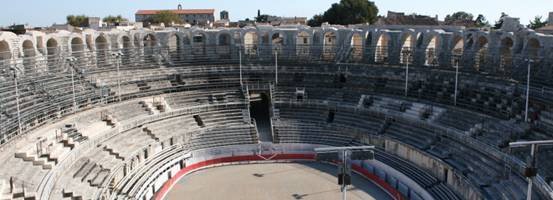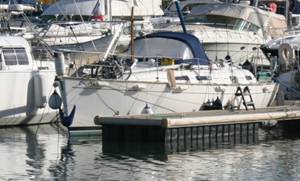Sunday 10 October 2010 - Port Napoleon

|
We have now completed our We left
We arrived at
Next day we set off for Port St. Louis, where we would be
leaving the
This time the lock-keeper announced that the opening
would be delayed until About 30 minutes later he explained that the lock had been closed (by the higher powers) and we would no be allowed in until the next day! We took the opportunity to talk to the supervisor of the small dredger/barge who was very sympathetic and he suggested we could moor up against a nearby river authority tug (which would be easier and more comfortable than against the wall). So we moved yet again and were in a better position when the dredger/barge recovered the badly-battered car and returned it to the shore.
It was a reasonably comfortable night, rafted up to the
small tug, and we were up early the next morning to catch the
After emerging from the lock we passed through the Port St Louis yacht basin (where we had intended to pass the previous night) and follow the Canal Saint Louis for about one-and-half miles in a north-east direction and then follow the well-marked Canal St Antoine more-or-less due south into Port Napoleon.
Port Napoleon is a massive purpose-built marina and boat storage complete with all engineering facilities plus a club-house with temporary accommodation. The down-side is that it is miles from anywhere and you really need a car if you are intending to stay for any time. (There are a number of residents who come in for the winter months and live on their boats.) We checked in and confirmed our winter booking out of the
water. We were very relieved to
find that our mast had arrived safely form
Because we had arrived here about a week earlier than we had planned, we decided to rush home and collect the car so we could empty the boat once it was lifted out and thus avoid the need come down later and empty the boat. We flew home on Friday 1st October and drove back on Sunday 3rd. We are now busy winterising the boat (changing engine oil, oil & fuel filters, etc.) and getting it ready for lift-out on Monday morning. We can then complete the tasks by putting anti-freeze in the engine and arranging with local tradesmen to complete a number of maintenance tasks before we return to the boat next April. Although the weather today is miserable – windy and raining, most of the week has been quite sunny and pleasant, although the days are shorter, the sun cooler and the autumn windy are making their presence felt. On Thursday and Friday we took time off to explore the Camargue, discover some vineyards and rice fields, try and spot some flamingos and visit a bull-fight. On Thursday afternoon, we had noticed a poster advertising the event at Vallabregues - a village alongside the Rhone some way north or Arles - so we went there of Friday afternoon.
It’s not really a bull-fight, it is the local version of bull-running (‘course camarguaise’), it is very popular in this area and most of the larger villages appear to have their own arenas.
There are six young, and very agile, young men in a ring with a young bull. Their task is to pluck the miniature “rosettes” which are attached to the bull’s head between its horns and they do this by running past the bull, trying to reach its head and then leaping out of the ring and high onto an outer wall before the bull can catch them. The bull, meanwhile, is bit annoyed at all this teasing and chases any of its tormentors and tries to attack them. Not only do the young men (raseteurs) get applause when they pluck a cockade, or tassel, from the bull’s head but also the bull gets applauded at the end if they showed spirit and provided a good spectacle. Meanwhile the announcer is increasing the value of the cockades to incite the raseteurs to be more daring.
Occasionally, the bull manages to follow his tormentor over the fence and finds himself in the (previously) safe outer zone. The helpers quickly hide behind barriers and all the raseteurs get into the ring. The bull is then enticed back into the ring by opening the appropriate gateway.
After the allotted time (about 10 minutes) the music plays (extracts from Carmen) and the door is opened to allow the bull to return to the pen. A minute later, a new bull is released into the ring and the event continues. I think we saw about 6 bulls and nobody was hurt. We were not very sure of the rules – who get points for what – and there was no closing ceremony to announce which of the young men had “won” or achieved most. It is quite a spectacle and the audience was mainly local pensioners but they seemed to enjoy it and encouraged both the bull and the raseteurs. (I couldn’t help but think of the tricoteurs knitting in front of the guillotines.)
Now it is time to go back to the various jobs ready for lift-out tomorrow morning. If we get all the jobs done, the estimates arranged and the boat emptied of all clothes and books by mid-week, we can set off homeward in a leisurely fashion and get home at some time over the weekend. However, we will post a closing blog later in the week. Ron & Elizabeth
Ron & Elizabeth HOWARD Eliza B, Moody 36 + 44 7768 816 579 + 33 (0)6 11 66 79 08 Http://blog.mailasail.com/elizab
|

























